Personal Connections Might Be the Lifeblood that Fuels Crypto Art Collecting
An Essay About Crypto Art Collectors by Maxwell Cohen
This is the second of a series of five essays written on crypto art collectorship through the Summer and Fall of 2023. These essays were based on 18 interviews conducted in April and May 2023. While not every collector interviewed appears in every essay, their collective insight heavily influenced the direction and creation of these essays. I extend utmost gratitude to them all.
Today’s Players:
Omz: Collector since 2020. First NFT: The Protector by Trevor Jones and Jose Delbo
Artnome: Artist, Popularizer of NFTs. Collector since 2017. First NFT: Moxarra
Sarah Zucker: Artist. Collector since 2019. First NFT: Digital LSD — Synthesis_Batch_20190505 by FractalEncrypt
Anne Spalter: Artist. Collector since 2020. First NFT: Chromie Squiggles by Snowfro
TokenAngels: Collector since 2019. First NFT: Autoglyph #504 by LarvaLabs
Mattia Cuttini: Artist. Collector since 2018. First NFT: IlanKatin, More the Journey than the Destination
BelleNFTs: Co-founder of NFTGirl. Collector since 2021.
Coldie: Artist. Collector since 2019. First NFT: Cryptopunk 7933
Conlan Rios: Founder of Async.art. Collector since 2019. First NFT: Cryptokitties
Batsoupyum: Collector since 2021. First NFT: Hashmasks
Artie Handz (Punk 7635): Collector since 2020. First NFT: NBA Topshot
Additional thanks to: Samir Mitra, NFTFeen, TennesseeJed, Sats Moon, ProteinProsecco, Cozomo de’ Medici, and Pindar van Arman
Craft shows — whatever they are — run in my blood. Well, theoretically. I’ve never actually attended one of these mythical events myself, but my grandparents, Bob and Sue, frequented these so-called “craft shows” for the last half-century, returning from their mysterious excursions with Tobi mugs to further overstuff their shelves, framed prints and hanging gewgaw (a four-foot wire mantis covered in chromatic fabrics, impasto-heavy abstracts, a decorative iron from the 19th-century) to weigh down their drywall. The pìece-de-résistance of their ever-eclectic collection, however, has for decades been the dazzling litter of life-size artisan dogs numbering by now in the dozens, metal and wicker and paper-mache and clay terriers, poodles, schnauzers lazing by the stairs or guarding the guest bed, or, weather-proofed, peering out with pointed tail from the edge of the porch.
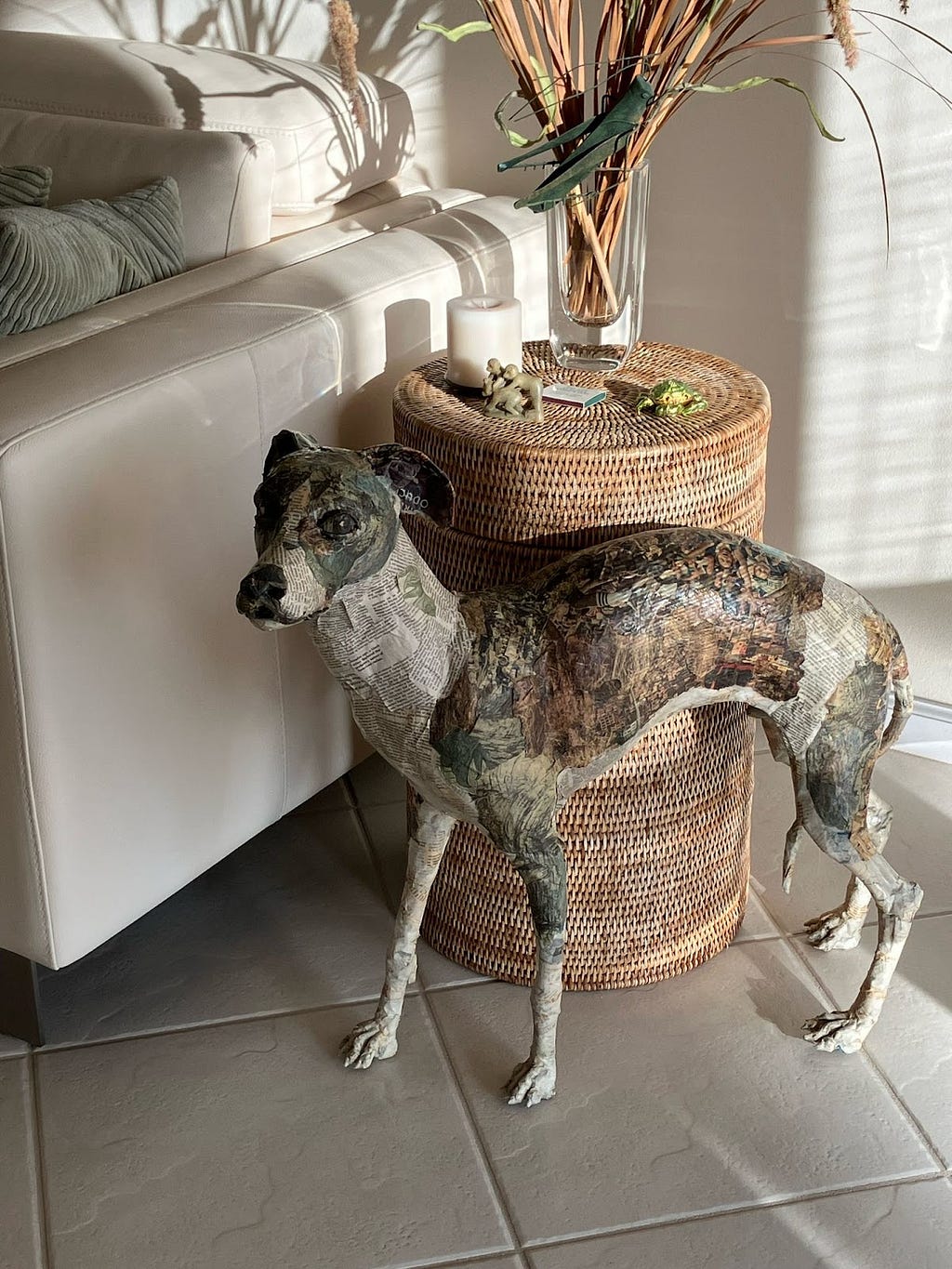
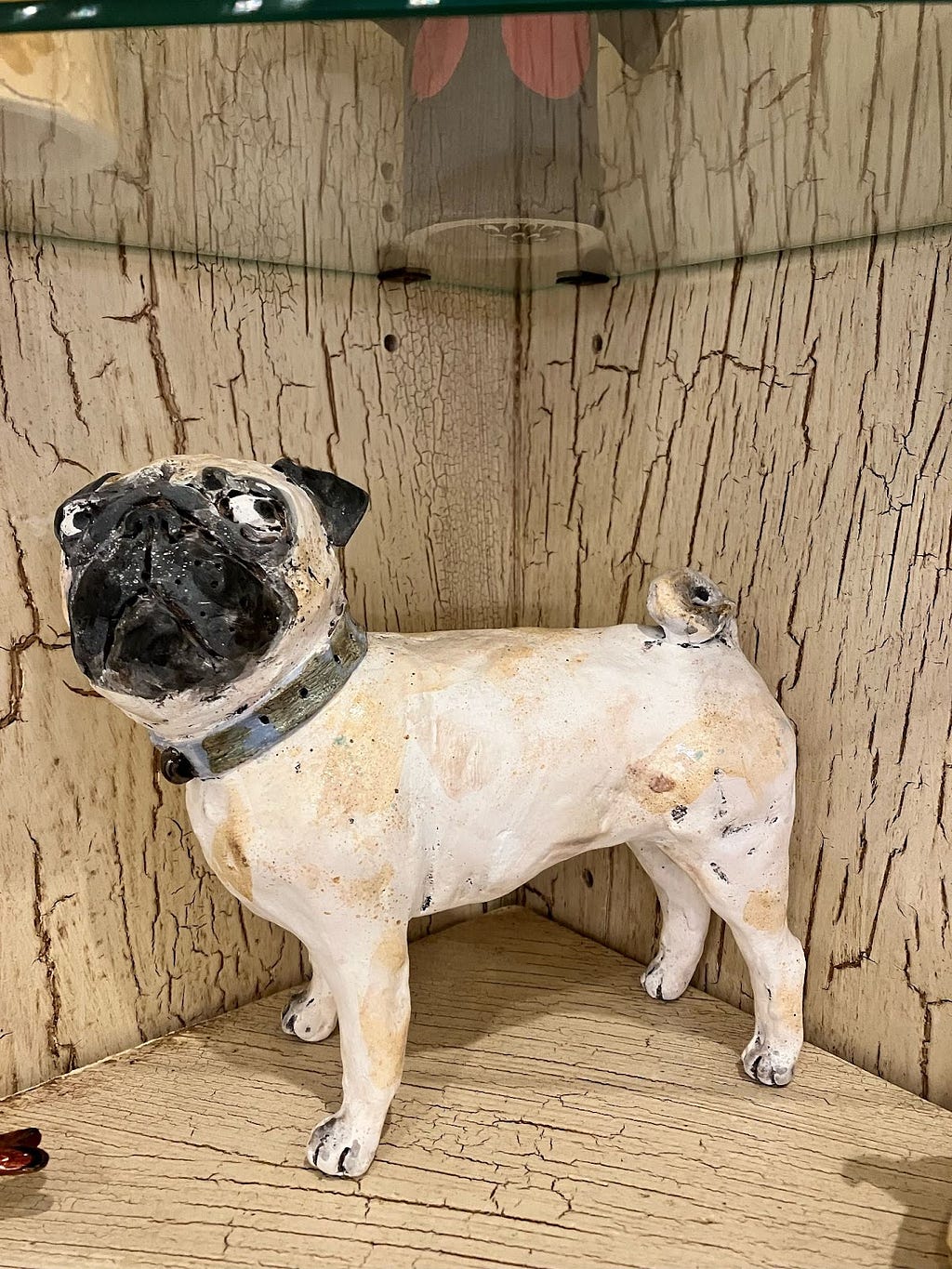
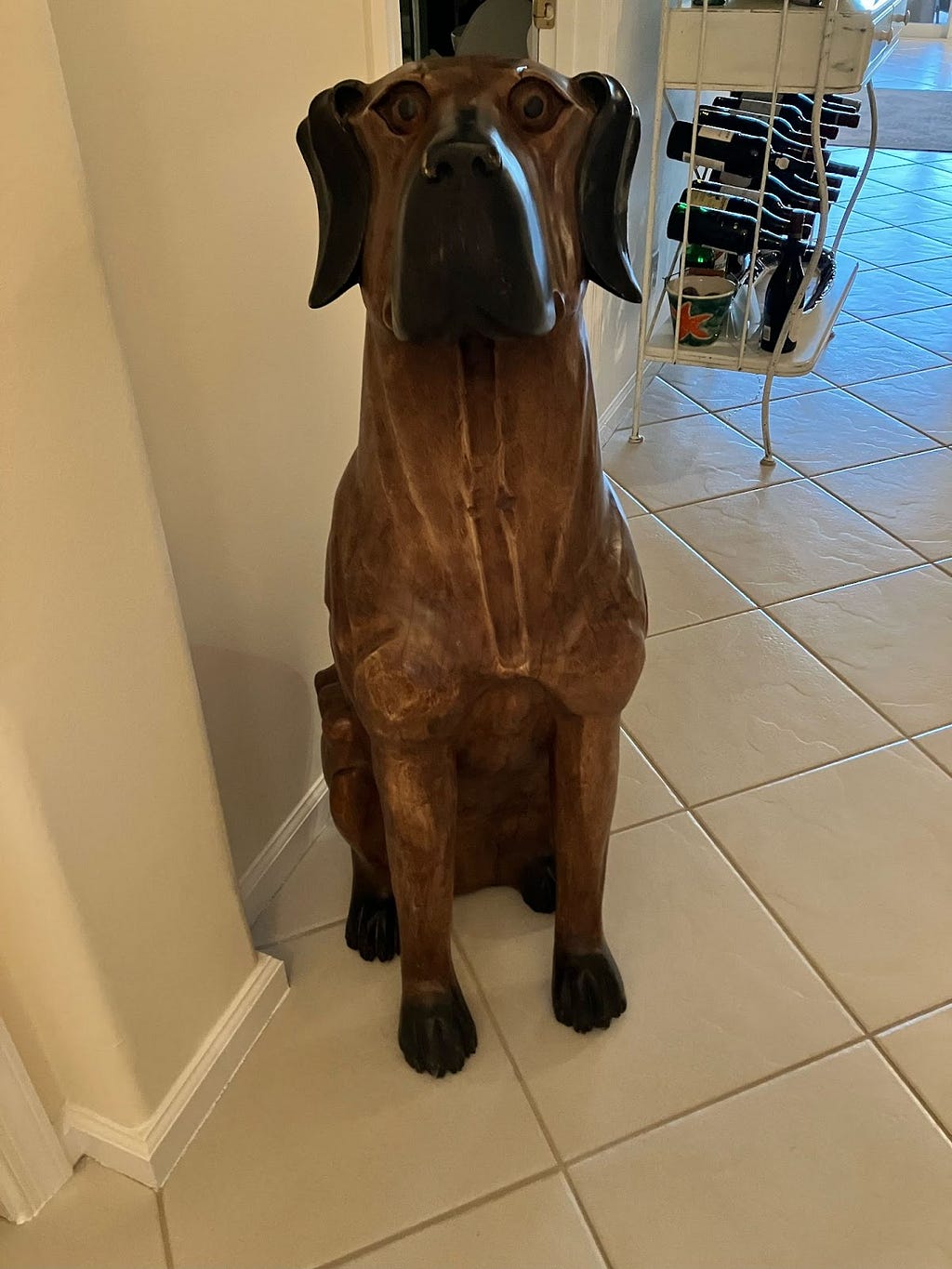
With the art itself my only reference, I envisioned these craft shows as massive artistic carnivals, raucous as State Fairs. I pictured auctioneers in candy-striped attire collecting shrieked bids, which’d come pell-mell from a frothing crowd of art aficionados.
Turns out that “craft show” is somewhat of an abstract term. Knowing my grandparents, they likely developed their own lexicon over the years, using that catch-all term to describe a host of bazaars, flea markets, art auctions, street fairs, etc. I imagine that all these events were much smaller and better-behaved ordeals than what I once believed. Having little in common with carnivals, I believe they looked a lot more, in fact, like my mother.
First of all, you probably don’t know my mother. You’re missing out. She has the kindest, warmest energy about her. She makes a comrade of everyone she meets. She likes to drink out of straws and dance in tame beachside crowds to Grateful Dead music. She is also, as of a few years ago, a self-identifying artist.
What began as a meditative technique — painting concentric circles of tiny dots on rocks and seashells — has since exploded into a genuine and curious artistry, one which has since consumed canvases and 12-inch records, guitars and bottles and earrings, every surface she can get her hands on. The woman’s creative energy still manifests at times in dots, but now also in waves and paint-pours and mandalas and pop flowers and abstractions, her art literally littering the loft where she works. To walk into this room is to be assaulted with color. But to walk into this room alongside my mother is to be assaulted by both color and contrast, for there beside you is this lovely petite woman, but there also is the vastness of her creative spirit, towering over the house, bursting out beyond its acreage.
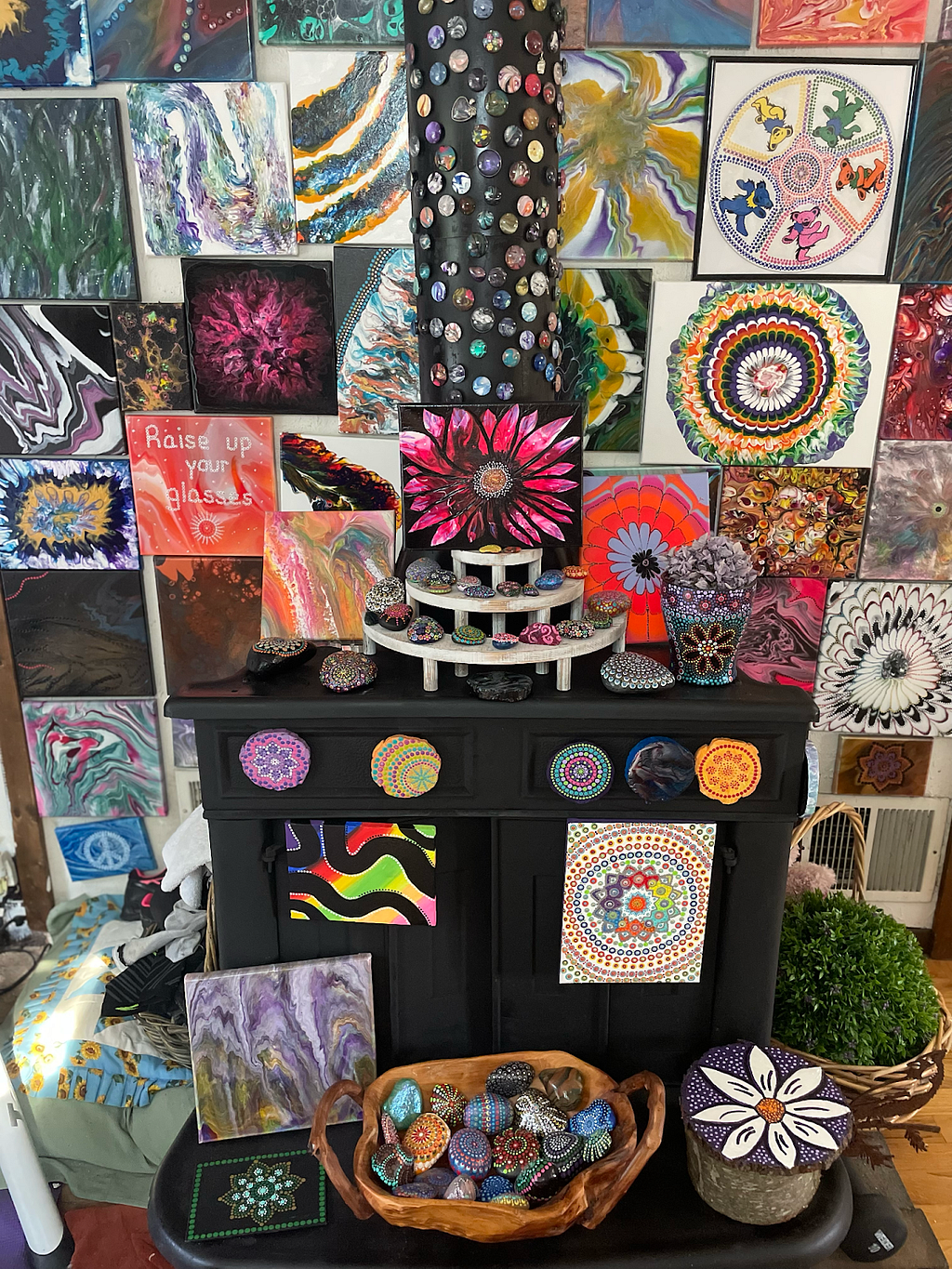
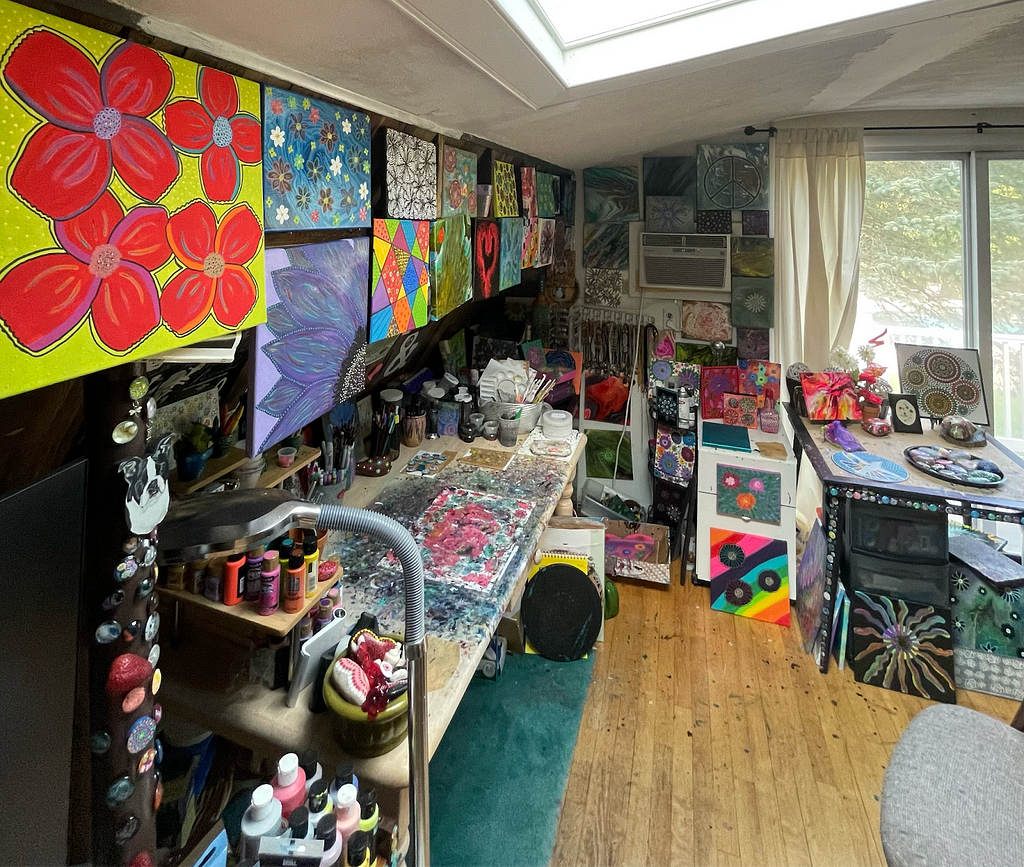
A few weeks ago, my mother sat at a folding table outside a head shop in Neptune City, New Jersey for what was her first public display of artistry, a small-time “craft show” featuring about a half-dozen local artists. Knowing my mother, she would have smiled at every stray passerby. I’m sure a few were attracted by her brightly-colored art, but it was undoubtedly her grace and charm which would’ve really enchanted them. She sold quite a few pieces, for which I’m very proud of her. But I also have a sneaking suspicion that if she were not present at that table, did not take prospective buyers on a little tour of her spirit and psyche, she would not have been nearly as successful. Because when you see that face, hear that voice, and then look at the art, it takes on a different tenor. The colors are brighter, and you see the scenic spot inside her from whence they’ve flowed. That’s a hard thing to resist. You meet my mother, and you lose interest in resisting it at all.
I think back to my grandparents, sauntering through what was probably just a series of recently-erected tents and tables in a parking lot somewhere, peripherally interested in purchasing another decorative Doberman, sure, but confronting an overwhelming number of opportunities to do so. Why this dog over that one? Each would have had its own aesthetic merits, but there must have been so many smiles, so many stories, so many spirits calling for their attention; how could these not have been just as, if not more, important than the dog itself?
But at a certain level of institutional success, from what I understand, the gift of seeing and speaking with an artist is forcibly removed. Many artists hire assistants to sit at their tables and assault interested parties with buzzwords. Others show exclusively in galleries. And as Anne Spalter told me, “If you go to a gallery and you buy an artwork, the chance of your becoming social media friends with the artist as a matter of course is low…If you just walk in as an average person, the gallerist might not even let the two of you connect. There’s an enforced separation.” Conlan Rios believes this paradigm stems from the modern gallerist’s job itself, which is “To hype up the artist and add this mystique, so you feel like, yeah this thing is worth $15,000.”
This is logical. I mean, who wants to man a table their entire career? And I can understand why the personal nature of an artwork’s creation is profitable only to a point, after which high price tags require mystery or the Mad-Libs stereotypes of genius to justify themselves. But how profoundly limiting! We all know that context imbues art with significant additional meaning. And that meaning — gleaned from the artist’s style, their manner of speaking, their selves — is often what we attach to when deciding on a purchase. The work loses so much when the artist is alien to us. The fullness of a person is replaced instead by proverbs and marketing, and thereafter, so is the art. Think of how much the art is kept from becoming…
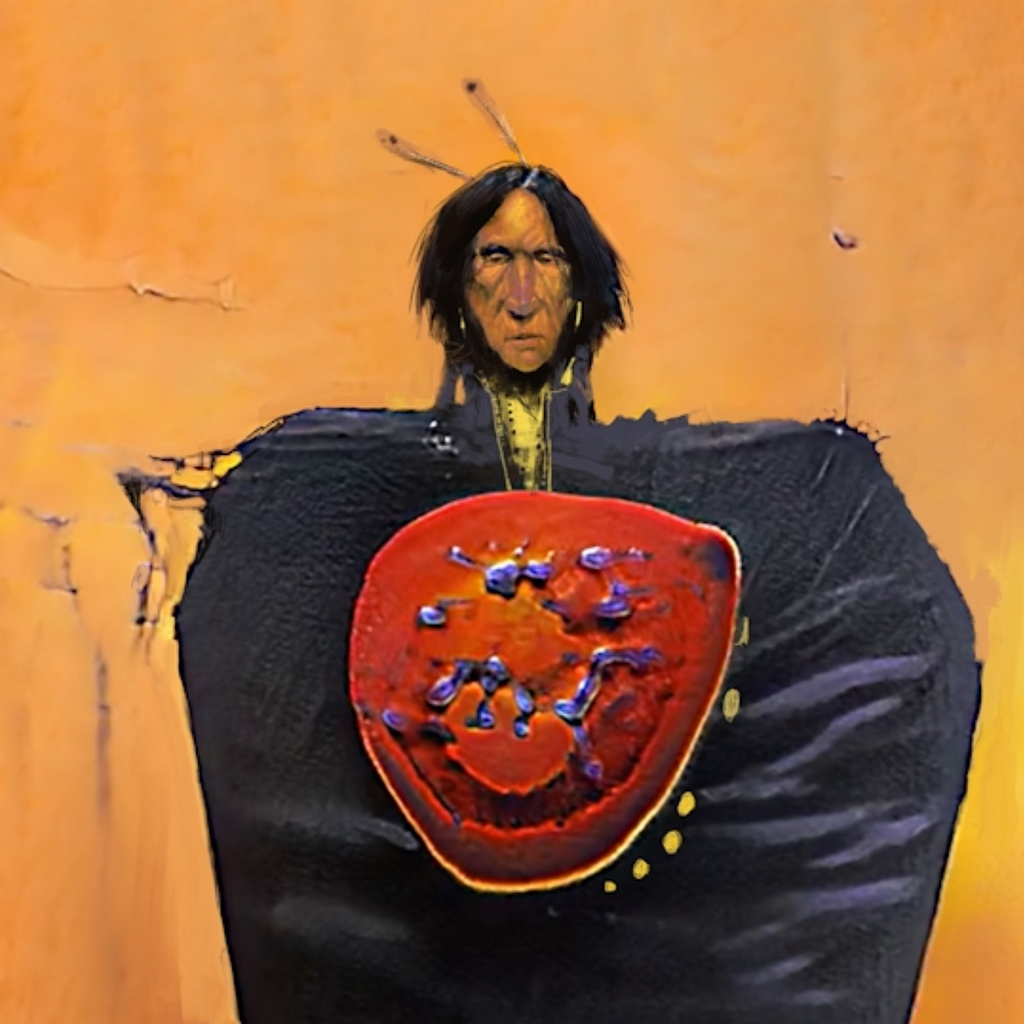
I spoke in my last essay about Artnome collecting a piece from Moxarra in 2017 for just a few dollars, and Moxarra reaching out afterwards to personally say thanks. In a vacuum, there’s nothing so spectacular about the encounter. But then you think how the two were separated by a national border, let alone thousands of miles, and didn’t know each other beforehand. “The lightbulb for me,” Artnome said, “was I spent three bucks, and now I’ve got this creative friend for life from Mexico. If I spend another three bucks…I can meet all these like-minded artists from all over the place, and share and build this global family and show support, not only through the money…but through that act.”
In crypto art, the craft show — or Grand Bazaar, Roman Agora, call it what you like — is constant. It crosses borders, cultures, distances, language barriers, everything. Unlike the traditional art world, there isn’t — no, there can hardly even be — a separation between art and artist because they are both encountered and interacted with in the same entirely-online locale. Both are always on and always there, waiting to be experienced. I was shocked by how much these 18 collectors were motivated by the potential for personal connections with artists. And in an artistic ecosystem where aesthetics are routinely excellent, where technical expertise is expected, where there is art for every mind at every price point at every moment, this seems noteworthy. As Batsoupyum told me, “I collect what I love. But the far more interesting piece to me is the artist themselves. Their story. Their journey. Their creative process. And their background is also important to me….”
After all, it’s one thing to hear an Aretha Franklin song. It’s another to see her scrunched face, the smile, the half-balled hand raised up to her side, the confidence, the whole form contorted with the vocal chords, and hear the song coming from her personally.
Of all the collectors I spoke to, BelleNFTs probably summed up this facet of the crypto art collector’s mindset most comprehensively. She said:
“It’s like dating…no matter what, you first see the aesthetics, and that’s always the driving force of it. But now when I look at something, it’s not just about the aesthetics but more holistically about the artist: What has the artist already created? Where do I think the artist will be a couple years from now? How ingrained are they within the space? And then also being a Latina, being a woman, I’m immediately drawn to those that don’t have the same platform as others…A lot of the time, some of my favorite pieces are when I’ve seen something aesthetically pleasing and then listen to an artist on a Twitter space or podcast or IRL, and it’s not only connecting with the piece itself just for the aesthetic purposes but also with the person, and what they were thinking when they crafted that, and what they are thinking of now.”
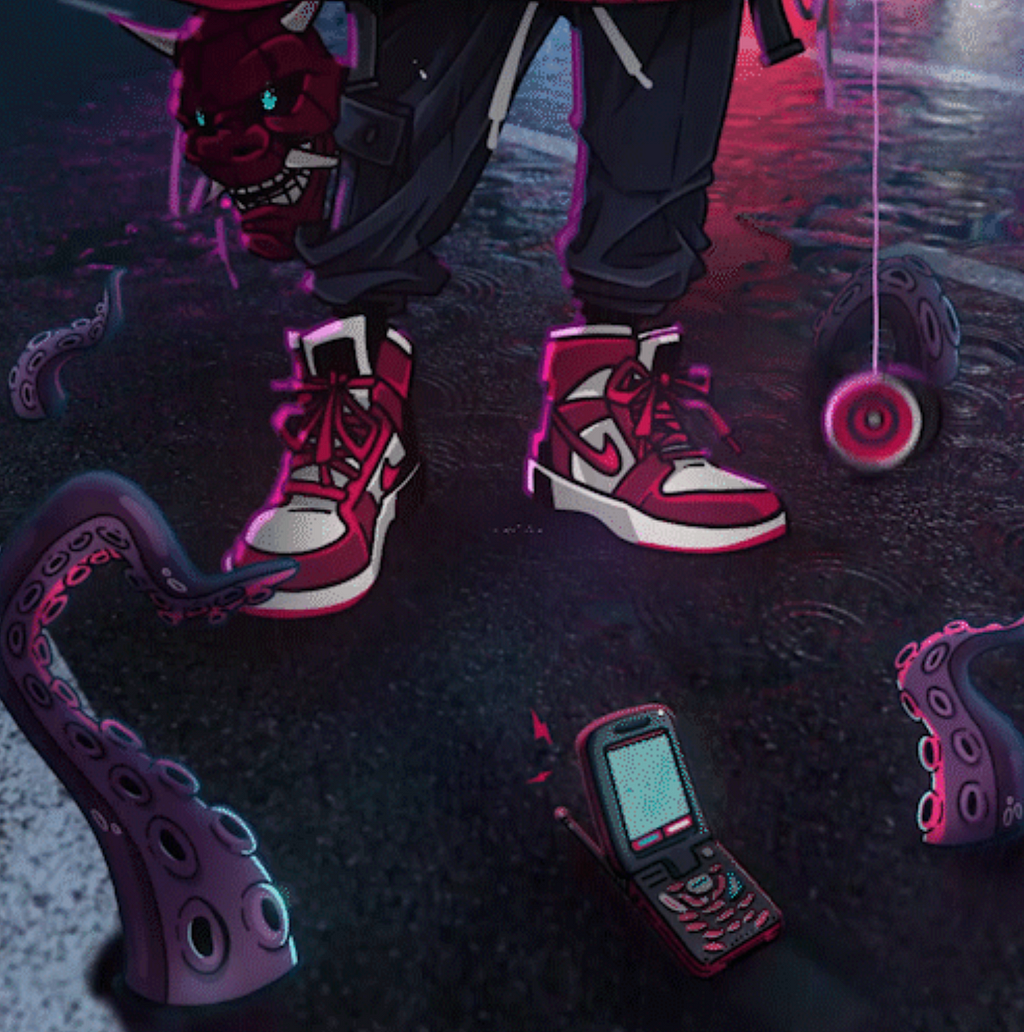
Because it’s wholly online, crypto art is submerged within its context. Belle just described a series of very specific communication types (meaningful as they may be to an artist’s ethos), but a very light amount of research will often reveal all of them and all at once. But also, by simply existing in this space for any amount of time, you are incrementally exposed to aspects of artists’ personalities that help fill the gaps-of-meaning for their past and future creations. The connection to their spirit comes automatically, to an extent. In many cases, you can’t avoid the personality of an artist, their story, their penchant for rabble-rousing or empathy, because to see their art is also to see their Twitter page, or their SuperRare bio, or see all their other artworks on the same site, hear them on a podcast, read excerpts from an interview, see what they retweet, witness their interactions with others, their little messages of gratitude (or otherwise), their lines in the sand, the seriousness with which they take themselves. All of that is going to add further dimension to the artworks themselves, which is not just a boon for artists looking to maximize the meaning of their work, but for legitimate collectors looking to find art which is legitimately meaningful to them.
Coldie was very blunt in his assessment that, “You get to know peoples’ art, and then you talk to them, and the art starts to speak differently once you know the person.” But TokenAngels’ was positively emphatic, asserting that “art, especially nowadays among living artists and collectors, should be relational. You should have a relationship with the artists; you should speak, you should be meeting, you should exchange thoughts, you should visit him, you should invite him somewhere if you have the privilege to spend some time with them, you do it because that’s the best thing you can do.” In this paradigm, all parties — artist, collector, art — can, do, and should benefit from the nearness they have to one another.
This benefit can, and often does, go beyond cheerleading or even friendship. In Mattia Cuttini’s words, “There’s people all over the world who if you buy artworks from them, you can change their lives. Think about people that are not in the US and are not in Europe: If you buy work for 100 dollars, that’s a lot of money for these people. This is why I bought artworks from Brandon Walsh and from OnThinIce, and from Nick Yashika, a Ukrainian photographer. He’s really great, but now he is really down in money, his artworks are so cheap, but $100 for his art is life-changing!” I remember in the immediate aftermath of Russia’s invading Ukraine, I purchased a hastily-editioned work from the brilliant Ukrainian photographer Artem Humilevsky. The entire collection today has achieved only .85 ETH in sales, which for someone in America or Western Europe might be seen as a pittance, but for someone literally fleeing a warzone, that money must have stretched so much further than it appears on the surface. I’ve never spoken to Mr. Humilevsky, but I feel closer to him nevertheless for this tacit interaction, one that emerged entirely from context I was unconsciously exposed to.

Omz doubled-down on this as the trademark inclination for his collection. “Yes, you’re collecting,” he said, “but also you’re connecting with artists, dreamers from all over the world, you’re able to support them in their journey, and it’s magical… I think that aspect of it is very unique to this space, the way you’re able to forge these relationships with these artists…You don’t get that anywhere else, so you end up building really deep relationships with artists, and you end up really being a part of their journey in a way you can’t otherwise.” Sarah Zucker and Batsoupyum made the same point, almost verbatim.
Artie Hands (Punk7635), took it even a step further, saying, “The thing I love about crypto art…is the direct involvement with the artists, and how you’re more involved with, maybe it’s stretching to say of the creation process, but you’re often involved, and people are getting inspired by you.” I think there’s real merit in that, for how can an artist not be influenced by the belief of their collectors or the passion of their admirers? For a lot of collectors (I’ll be writing at length about this in the future), collecting artwork is a primary form of expression, a craft similar in effect to the artistry itself. The increased context, the connection, the reflected sensibilities that patronage provides, all can prove as powerful to the collector as to the artist, what with the collector’s influence having the potential to manifest — in ways both subtle and overt — in the work itself, or even throughout a larger oeuvre.
Now, it is obviously misguided to suggest that such personal connections are totally absent from the traditional art world in general. We know that patronage relationships like those between Picasso and Gertrude Stein, Artemisia Gentileschi and the Medici family, or Michelangelo and Pope Julius II were responsible for some of history’s most renowned works. But access to the Pope, the Florentine Duchey, or one of the greatest 20th-century cultural salons was an extremely exclusive privilege. Naturally, if you have to meet the wealthy and powerful in-person, share the same physical space as them, or pass a social background check in order to connect, that disenfranchises 99.99% of artists. As with so much in blockchain’s orbit, the real revolution lies in accessibility.
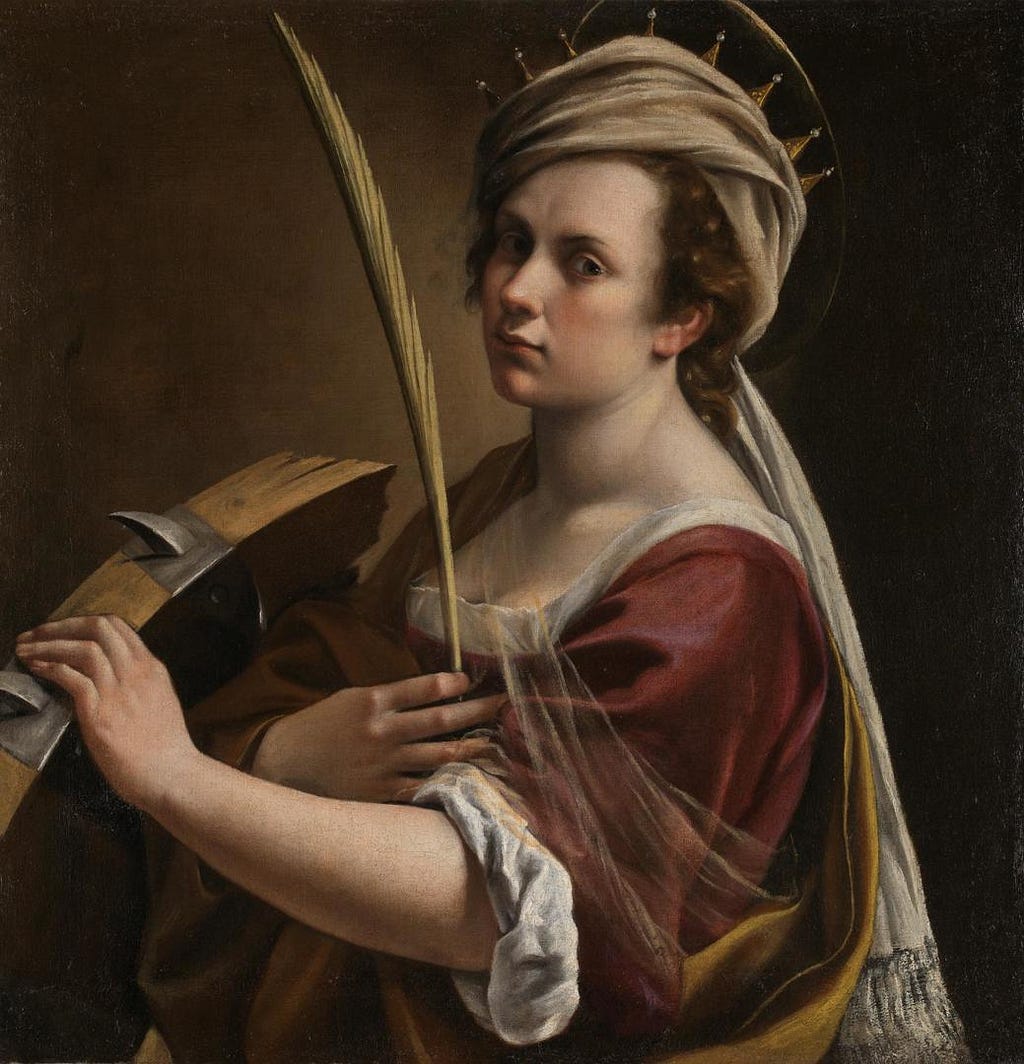
In theory, collectors looking to engage in patronage can find new targets for their patronage everywhere and all the time, whether actively seeking them out or not. This is the nature of social media in 2023, when content, conversations, and creativity are algorithmically thrust in front of you whether you like or not. It’s clear when looking at the most consistently successful crypto artists that some of their achievements stemmed from technical ability or first-mover advantage, others from demeanor, others by seeming accident, others from sheer hustle or adherence to brand mechanics. My point is that there are more pathways to connection with collectors, and ergo success, than ever before, in large part because all of crypto art — its platforms and players — exist in a kind of bubbling cauldron where information and interaction rise unexpectedly to the forefront (though it is worth noting that success seems to be easier achieved by white, male, English-speaking artists than others).
But crypto art’s nature of accessibility also manifests in the simple access we have to each other in the first place. Outside of our more privacy-minded principals, pretty much everyone is open for messaging on one platform or another, and this allows for support that is not just financial but psychological. Listen: I’ve spent the better part of a decade writing weird fiction for an audience of exactly zero people, and receiving extremely little appreciation for it in the aftermath. A kind word — or a few — can be indescribably meaningful. Sarah Zucker emphasized this within her own experience, saying, “I often point out that support comes in many forms: There are so many ways to support an artist and participate in their community without necessarily directly collecting their work. Psychic and social support are honestly just as valuable as financial support.” That sentiment applies to all artists everywhere, but especially to crypto artists, who work in a space that can oftentimes feel demeaning, hair-trigger, and just plain scary.
With this in mind, I believe many more of us need to begin self-identifying as collectors, because we wholly lack in how much psychological support we offer to the artists who personally populate the space around us. Coldie’s empathy-minded perspective on this subject spilled forth when he said, “I am every other artist out there. I went through my whole life being fucking broke as shit, living with a buddy above a garage making art, because that’s all im good at….And there’s so many tens of thousands, hundreds of thousands of artists that are proverbially me. And so when I look at art, already I’m invested in creation.” Lord: May more of us, and more often, be invested in it too, and show our investment in whichever ways we can: financial, psychological — if you take one thing from this essay, it should be to go out and tell an artist you appreciate them. Do that, and the fundamental dream of crypto art is kept alive at least a little longer.
Finally, an anecdote: For years, my mother flat-out refused to sell her artwork, despite repeated calls from friends and family to start making some cash for these things she spends hours every day creating. Yet, she still wanted people to own her work and receive joy from it, so she went out of her way to make that happen. Someone complimented a necklace she’d made? My mother would get an address, put a package together, wrap a few canvases, some earrings, a painted rock or two, a personal note. It was enough to have her work be seen, appreciated, known, to enrich someone somewhere even a little, even just once.
I know we don’t all currently perceive ourselves as collectors, but if you’re reading this essay, you are very likely a connoisseur in this hyper-modern art movement. A hyper-modern art movement that flows over and throughout us all, from spirit to spirit, tweet to tweet, kind word to kind word; we shepherd crypto art along in the foreground while the blockchain does so in the background. Every block has an indelible effect on the history of the medium. And so too do we, but only when we connect. This fact is not just worthy of acknowledgement, it may be the very bedrock upon which crypto art, as a social artistic movement, is advanced. Making such connections as we’ve discussed today is more than a perk of crypto art, it may be the movement’s categorical imperative.
So go tell your loved ones you love them, and then go tell an artist how their work has made you feel. Be recklessly supportive. Artists will almost certainly respond, and in that exchange of emotions will come an exchange of meaning as well. Their art will sing louder, and you will come to better recognize the key in which it does so. That has proven irresistible to many. Perhaps it will to you too.
If you enjoyed this essay, please subscribe to our Substack to get all our writings, podcasts, updates, and other incredible content delivered to your inbox directly. And listen to the MOCA LIVE podcast every Wednesday at 5pm EST, or find it wherever you get your podcasts.